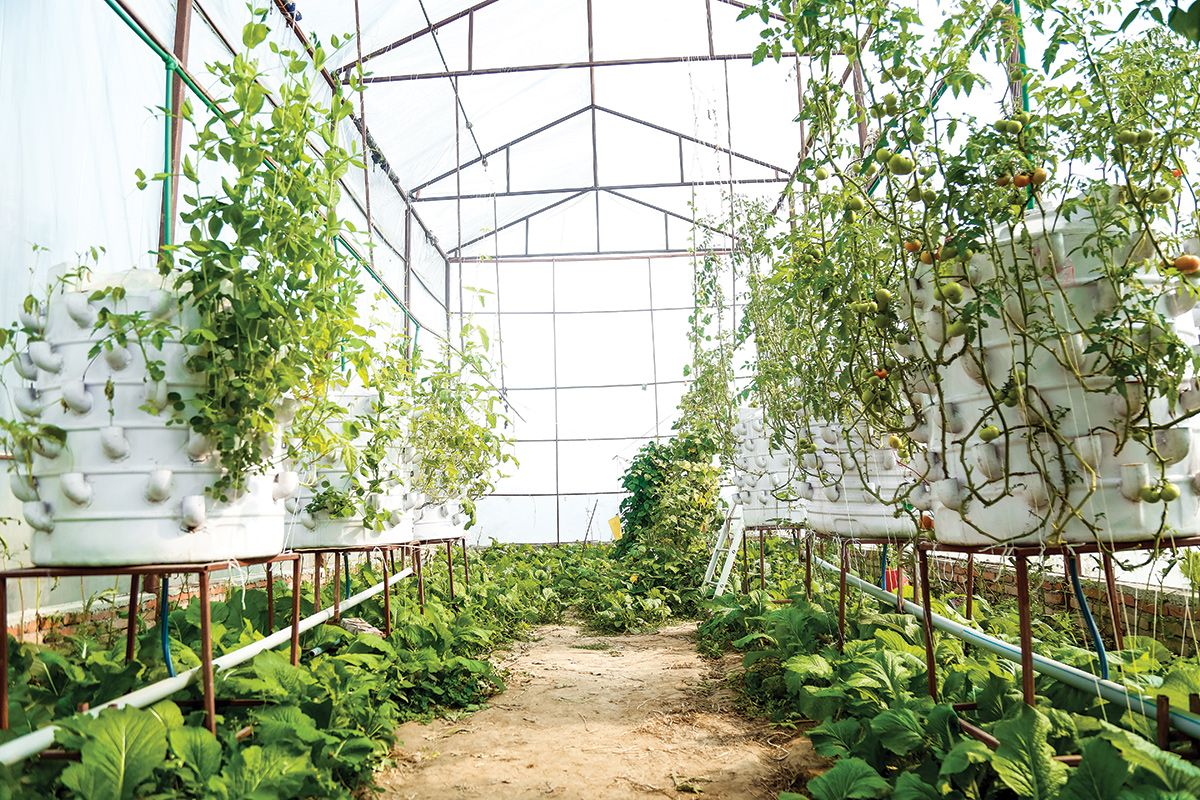
In the 90s, the National Aeronautics and Space Administration (NASA) tested the effectiveness of an experiment on the Mir Space Station. The subsequent results revealed that plant seedlings could effectively grow in a nutrient solution at zero gravity. The research and experiment conducted by NASA laid the foundation for an innovative hi-tech agriculture company to be established in Nepal. The technology in question is Aeroponics and the Nepali company is AeroRoots.
AeroRoots, founded by Caesar Rana and Biplove Singh in September 2017, is a hi-tech agriculture company dedicated to eradicate pesticides from vegetables by applying a novel technique called aeroponics. Subin Shrestha later joined the team in 2018. As Rana explains, “The idea was under process for six months prior to the actual implementation. We experimented for months in the roof of my Kalanki house before the results gave us the motivation to take this as a legitimate business solution.”
What is Aeroponics?
It is a revolutionary new technology first developed to grow food beyond the limits of our planet. The technique is soilless and supplies nutrients for the plants directly to the roots which are suspended in the air using ultrafine high pressure mist.
Rana describes, “Aeroponics is a modern farming technique which is soilless. The roots are suspended in the air, hence the name ‘aeroponics’. ‘Aero’ basically means ‘air’ and ‘ponics’ means the ‘method of growing’. Geoponic means growing in soil; hydroponic means growing in water. The roots literally remain suspended in the air and we supply water and nutrient solution to the roots in the form of mist,” he adds.
The Beginning
About two decades after the resulting experiment conducted by NASA, the concept of AeroRoots was conceived in Nepal. After completing his Masters degree from Boston University, Caesar Rana Co-founder and Director of AeroRoots was pondering over starting a business in Nepal. He explains that he did not want to do something that was already being done; instead, he wanted to start something innovative. Consequently, he realised that there was a massive problem regarding the usage of pesticides in agriculture in Nepal.
During the initial stages, the founders of AeroRoots considered various options to tackle the pesticide problem in the agriculture industry. Traditional farming was not viable. As they were venturing into hydroponics, they discovered something more advanced and more appealing in the form of aeroponic. However, this was not a ‘light-bulb moment’. Neither of the partners had any prior knowledge of agriculture; Biplove was in banking whereas Subin and Caesar were involved in insurance and academics respectively.
Rana laughs, “We got it straight out of the internet. When we first started, we did not even know what hydroponics was, let alone aeroponic. We thought plants can only be grown on soil. However, while we were researching about hydroponics we came across aeroponic.”
[su_row][su_column size="1/3" center="no" class=""] [/su_column] [su_column size="1/3" center="no" class=""]
[/su_column] [su_column size="1/3" center="no" class=""]
 [/su_column] [su_column size="1/3" center="no" class=""]
[/su_column] [su_column size="1/3" center="no" class=""]
 [/su_column] [/su_row]
[/su_column] [/su_row]
Left to Right: Caesar Rana, Biplove Singh, Subin Shrestha
Stroke of luck
In just a year span, AeroRoots has come a long way. But the story could have been completely different had Caesar Rana and his team not had luck on their side. In effect, the situation was tantamount to finding a four leaf clover. In their first batch of plants, only a solitary plant survived. Nevertheless, they were not discouraged. The fact that this single plant survived was a sign of hope that the experiment could work. Rana stresses, “We planted 150 plants and out of them only one survived. I think about it even to this day… if all of our plants had died in that trial phase, we would have quit. But because that ‘one plant’ survived and grew; we got excited and kept on experimenting. And thankfully in the second batch most of our plants survived.” Today AeroRoots’ results are exceptional as they save up to 90% of their saplings.
Why Aeroponics?
Whenever an innovative idea proves to be a real game changer; along with celebrations, there is also a host of reservations, doubts and skepticism. The founders of AeroRoots, however, stress that the benefits of this novel method overshadows benefits reaped from traditional methods. For starters, aeroponics drastically reduces water requirement needed in traditional form of agriculture. The aeroponics system used by AeroRoots currently requires 200 liters of water per week compared to hydroponics system and traditional soil-farming that would respectively require 2000 liters and 20,000 liters of water per week. Instead, aeroponics system nourishes plants with nutrient-laden mist directly to the naked roots of the plants dangling in the air. In aeroponic’s misting system, plants can grow exponentially well because their roots are periodically exposed to nutrient-rich mist. When the mist is created, it naturally cools down the environment inside the container where the roots are suspended.
“Hydroponics is very difficult to create in a hot environment because if the water temperature goes above 31 degrees celsius, plants die, which is rare under aeroponics because even if the water temperature is above 31 degrees celsius as the mist is introduced, it decreases the temperature almost immediately to 25 degrees,” explains Rana
The misting system intermittently sprays the roots with water and nutrient solutions which are proven to be beneficial for the growth of plants. Rana clarifies, “Nutrient solution is nothing fancy; it is just a fertiliser. The only difference is that water-soluble fertilisers are called nutrient solution in the language of aeroponics and hyroponics. Normally fertilisers are not water-soluble so basically by definition nutrient solution is water-soluble.” Various types of nutrient solutions are mixed and used. AeroRoots utilises nutrient solutions according to plant type, growth type and according to the season and temperature.
Since aeroponics is a soilless procedure; soil-borne diseases, pests and insects are drastically eradicated. “Aeroponic can eliminate up to 75% of fungal infections caused by the soil if you periodically sanitise the container,” explains Rana. “So having done all this, we knew the inherent benefits of aeroponic and we realised that this is the technology that will make our vegetables pesticides free,” claims Rana. Additionally, the absence of soil reduces many chores like tilling, preparing and weeding. Aeroponic farming can also be completely automated, allowing potential customers and growers to reduce their effort and time.
Additionally, due to the excessive ability of oxygen in aeroponic system, plants tend to grow faster and produce more compared to geoponics and hydroponics. Rana illustrates, “When we further researched, we realised that in aeroponic oxygen availability is very high because these things are literally suspended in the air, which allows the plants to grow in a very robust and quick manner and become resistant to diseases. Consequently, that decreased our need to use pesticides.”
Sustainability and Challenges
Every entrepreneur and innovator is met with challenges in his/her pursuit to establish the business. The team at AeroRoots faced distinctive challenges because their model is unprecedented in the country. “It’s very difficult because everything we do is brand new,” explains Rana. Even the apparatus and the tools they require have to be specially ordered because the suppliers are not used to selling the materials AeroRoots need on a commercial scale.
Another hurdle faced by the company is explaining their pioneering technology to government agencies. Procurement of even the smallest imported apparatus has been tough due to hefty tax imposed on imported goods. Rana illustrates, “Some of our nutrient solutions tend to get expensive and are heavily taxed and regulated by the government because they are unconventional products.” As a result, such challenges have contributed to increase in price of the final product.
What does AeroRoots Offer?
Over the past few months, AeroRoots has conducted extensive research and experiments, and consequently perfected their aeroponics system based on their product called AeroRoofs. AeroRoofs, stated by Rana, is a unit in a standard drum with a high pressured nozzel inside to spray water and nutrient solution that includes two grow-towers and has the capacity of 116 plants. Along with AeroRoofs, the company offers two other products and services called AeroGarden and AeroCommercial.
AeroRoofs is basically for nuclear families with limited space and/or for those who want to give aeroponic a try. It is a single or multiple drum unit that has 60 holes which can be installed in a balcony or any space where the customer sees fit. The company supplies AeroRoofs without a greenhouse system but there is an option to buy and install the greenhouse system as well. The price for the installation of AeroRoofs is Rs. 75,000. “It is quite popular among families experimenting with AeroRoofs at home,” claims Rana.
AeroGarden is a 4 drum unit designed for joint families and/or for customers who want to take aeroponic on mini-commercial scale. “AeroGarden is beefed up AeroRoofs,” states Rana. AeroGarden consists of 240 grow-holes. However, 240 holes do not necessarily mean 240 plants. The number of plants can increase or decrease depending on the size and type of plants. The installation of AeroGarden costs Rs. 150,000 which includes 4 AeroRoofs.
AeroCommercial is the company’s hi-tech commercial farm where they harvest aeroponics products in large quantities. “In AeroCommercial, we want to give aeroponics technology in a full set to interested commercial farmers. We provide 20 drums to 600 drums” claims Rana. The company is still experimenting with AeroCommercial. Once operational, their Godavari project will probably be the biggest aeroponics farm in South Asia.
Rana states, “Our unique selling proposition that sets us apart from the competitors is that we have a highly detailed user manual. Aeroponics technology is not that complex. But the running knowledge and scheduling regarding the aeroponics system is much more important than the technology itself. If you follow our instruction manual, you just need to spend 10 minutes a day for AeroGarden and 20 minutes a day for AeroRoofs”.
Future of Farming
Aeroponics technology is well on its way to become the future of farming. In many ways, this can be used to feed the world’s population because this technology needs small space, and the produce can be grown with limited effort and resources.
Currently, AeroRoots is one of the few companies in Nepal which can claim Research and Development at par with the world’s aeroponics R&D. “We can claim that we are not behind any other company not even AeroFarm; an American aeroponics company based in New Jersey,” states Rana.
“Some of the methods they use to solve a problem and the methods we apply are exactly the same. And it’s not that we copied from them; it’s just that when faced with problems, both AeroFarm and AeroRoots came up with similar solutions. In essence, this means that we are at the brink of cutting edge technology being discovered in aeroponics in the global context,” concludes Rana.


.jpg)


.jpg)